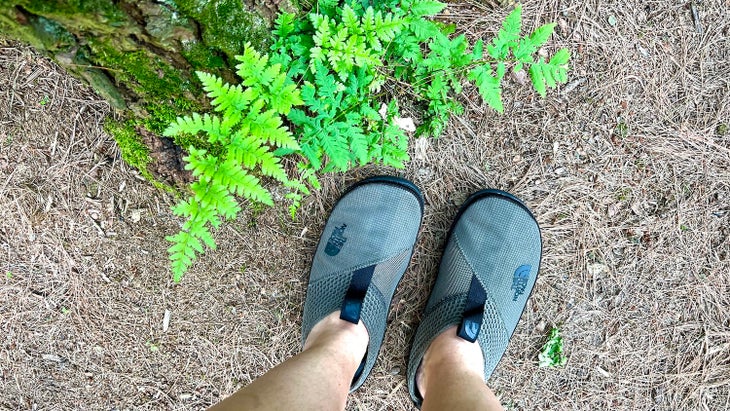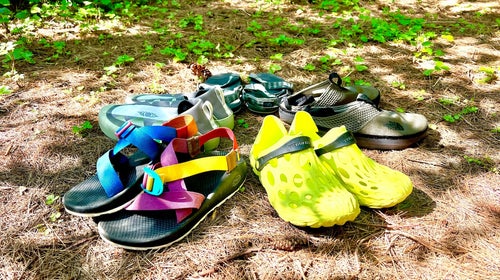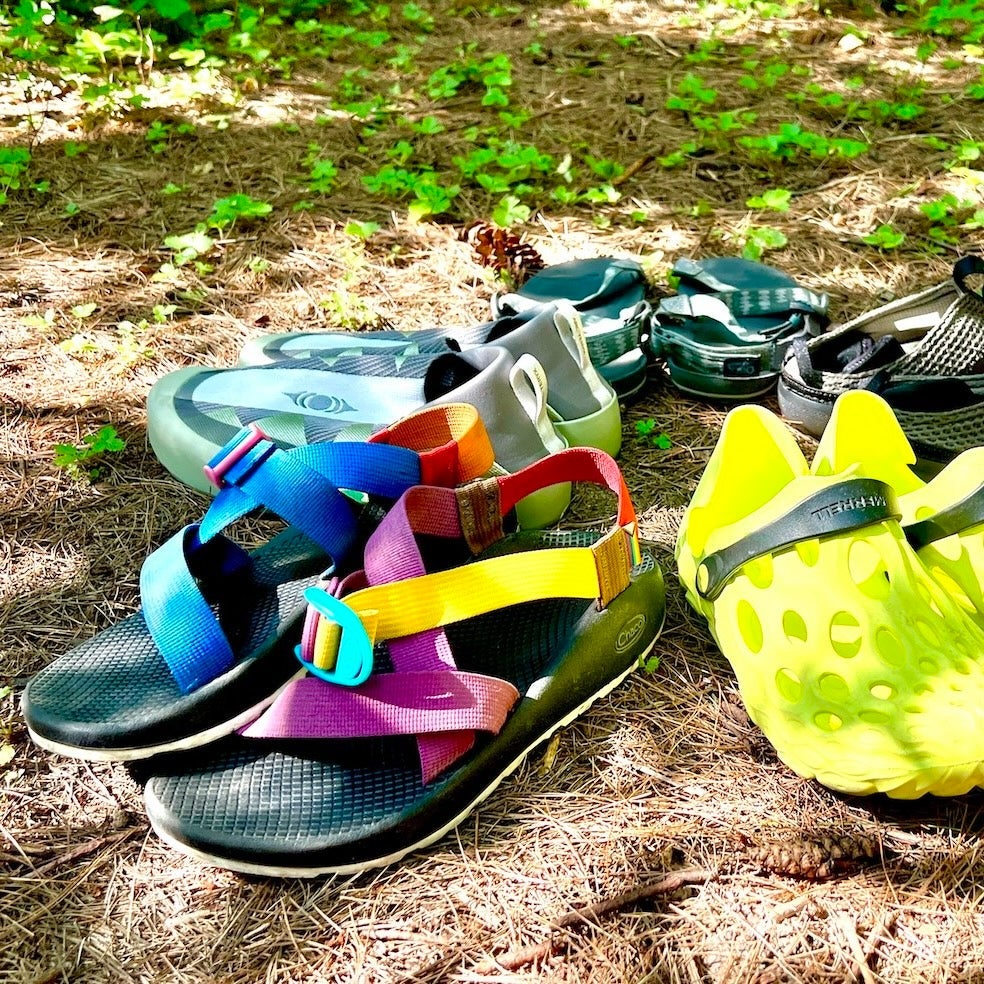Backpackers are no strangers to barking dogs. And, no, we don’t mean actual . We’re talking about sore and tired feet after a long day on the trail. Putting in the miles while backpacking, especially during months-long thru-hikes, can take a toll on your feet. All hikers run the risk of foot issues, from hot spots and heel pain to aching Achilles and bacteria buildup. When it comes to hiker foot health, there are many to feeling good again. We’re here to dig into camp shoes and footwear, specifically.
The idea of bringing camp shoes on a backpacking trip is a somewhat contentious topic. Some backpackers and thru-hikers think they’re a waste of weight. Others won’t hit the trail without them. I, myself, am a proud member of the pro camp shoe camp. In my experience, nothing beats the feeling of swapping or trail shoes for a pair of comfy camp shoes after a high-mileage day. I always look forward to slipping my feet into a lightweight, cushioned, and supportive pair of sandals or slip-ons to let my feet breathe, air out, and relax while at camp. My personal favorites include for trails with water crossings, for shorter backpacking trips, and sandals for longer treks where weight is top of mind. Like tents, backpacks, and sleeping bags, every camp shoe serves its unique purpose.
But do camp shoes actually help with foot health and recovery? And are they really worth the extra weight?
We talked with a certified sports medicine podiatrist to settle this debate once and for all.
What Are Camp Shoes?
Camp shoes—most commonly sandals, slip-ons, or a true thru-hiker favorite, Crocs—are lightweight and comfortable footwear commonly worn around the campsite after a day of hiking. Camp shoes are loved for the ventilation and cushion they provide compared to bulkier, more restrictive hiking boots and trail shoes. They give hikers a comfortable alternative to wearing boots and shoes at camp and allow their feet to breathe after a long day on the trail. The ideal camp shoes are lightweight and easy to pack—and are a popular choice for backpackers who want the convenience and comfort of an extra pair of shoes without too much added weight.

Benefit or Bust: The Camp-Shoe Conundrum
We won’t beat around the bush. Sports medicine podiatrist and former president of the American Association of Podiatric Sports Medicine (AAPSM), , says camp shoes aren’t a luxury item. There are key benefits to wearing them.
“I think many people will find the benefit of [camp shoes], especially after a long day of hiking,” says Dr. Conenello. “When you’re in the same shoes all day, it feels good to be able to use less energy to move and have the comfort of a recovery or camp shoe underfoot.”
Dr. Conenello’s podiatry practice, , is located a stone’s throw from the New York segment of the Appalachian Trail. He often advises his hiker patients to prioritize foot health when hiking, including examining feet post-hike, moisturizing frequently, and wearing camp shoes.
Dr. Conenello says camp shoes help the feet and toes splay naturally outside of a boot or restrictive shoe. Instead of being crammed into a hiking boot all day, camp shoes give your feet room to expand and air out, all while letting muscles relax. They also help limit bacteria buildup by giving your feet a break from being stuck inside a damp, sweaty boot.
Although he’s partial for their recovery benefits, Dr. Conenello says anything from cheap flip flops to more elaborate types of shoes like a recovery sandal or a secure slip-on with a back strap will work too. “Just make sure that if you’re planning to walk someplace that’s a little slippery or where there’s uneven terrain, bring a camp shoe that can dig in a little bit and hold grip on slick surfaces,” he says.
Another benefit of them is that they can also double as water shoes on trail. That way, hikers won’t have to get their boots or trail shoes wet during water crossings. Slipping on a pair of quick-drying camp shoes like Crocs, Hydro Mocs, or Xero Z-Trek sandals makes it more comfortable to wade through a creek or river.
“Of course, if you’re going to make a water crossing, or are walking around water, make sure the camp shoes you wear are waterproof or are vented in some way so that moisture can escape as they dry out,” says Dr. Conenello.
In terms of other basic foot health best practices, Dr. Conenello says it’s important to use moisturizer or lubricant, like Aquaphor or Vaseline, when hiking—especially in common areas for abrasion and stress points such as in between the toes and the heel. He says keeping the skin hydrated decreases the risk of developing hot spots that can lead to blisters, corns, and callouses. Despite popular belief, callouses aren’t a sign of tough feet built for the trail (unless you’re a barefoot hiker). In reality, Dr. Conenello says they’re a build up of excessive keratin that can lead to medical issues like plantar hyperkeratosis, which can cause pain and difficulty walking.
He also advises every patient to inspect their feet at the end of each day on the trail. “They should look at the bottom of their feet, look between their toes, and see if there are any kind of wounds or sores starting to form—and address them before they become a bigger problem.”
To Camp-Shoe or Not to Camp-Shoe?
Bringing camp shoes could add a pound or two to your backpacking kit. But do the benefits they provide outweigh that extra weight? We’d say, yes.


